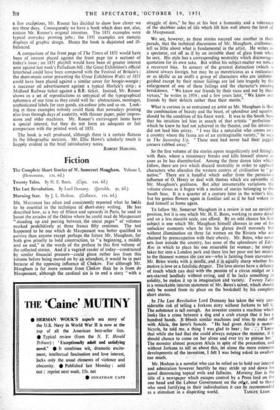Comparisons In Print
MR. CHARLES ROSNER has had the interesting notion of showing, in graphic form, changes in typographical manner during the past century. Unfortunately, in developing his idea, he has permitted his obvious predilection for so-called contemporary forms of graphic design to give an ill-balanced comparison between 1851 and our own time. The examples chosen by Mr1 Rosner to show the typo- graphical methods of 1851 are absorbing and entertaining, although it was probably a mistake to- reproduce the examples by the offset- lithographic process, which is apt to dull the freshness of letterpress originals, and certainly added to the expense of production. From these 1851 ephemera the general reader can gain a sound impression of the typographical taste of that time in- newspapers, magazines, invitations, time-tables, catalogues, sheet music and so on. All these examples have been well and skilfully chosen.
Such a gallery also presents a modest but instructive demonstration of Victorian taste. Here are the vulgarity •and vigour, the respecta- bility and complacency, the experiment and conservatism. We sense, too, something of that paradox which we see even more dramatically outside the printing-office. That race of supermen, who could build lighthouses and bridges of austere beauty, memorials and churches of squalid opulence, was scarcely likely to balk at inventing splendidly efficient printing machinery to print some of the lowest forms of graphic design the world has ever seen.
And this is where, to one attentive but captious critic, Mr. Rosner has slipped up. Here was the chance for a sober and profitable comparison of the printing ephemera of a century ago with that of our time:- magazine against magazine, newspaper against newspaper, type face against type face, bitihead against billhead. Instead, with a few exceptions, Mr. Rosner has decided to show how clever we are these days. Consequently we have a book which does not, alas, s6stain Mr. Rosner's original intention. The 1851 examples were typical everyday printing -jobs ; the 1951 examples are esoteric displays of graphic design. Hence the book is disjointed and ill- balanced.
A comparison of the front page of The Times of 1851 would have been of interest placed against the front page (or a section) of today's issue ; an 1851 playbill would have been of greater interest seen against last week's Palladium bill ; the Great Exhibition's official letterhead could have been compared with the Festival of Britain's ; the sheet-music cover presenting the Great Exhibition Waltz of 1851 could have been placed against a similar cover for boogie-woogie ; a macassar oil advertisement against a typical Horlick's strip ; a Midland Railway ticket against a B.R. ticket. Instead, Mr. Rosner shows us a set of reproductions as untypical of the typographical ephemera of our time as they could well be: abstractions, montages, sophisticated labels for rare goods, six-colour jobs and so on. Look- ing at these examples nobody could think that nowadays printing also lives through days of austerity, with thinner paper, paler impres- sions and older machines. Mr. Rosner's extravagant items have a special interest, but they do not form an adequate or fair comparison with the printed work of 1851.
The book is well produced, although there is a certain flatness In the lithographic sections. Mr. Ellie Howe's scholarly touch is happily evident in the brief introductory notes.
ROBERT HARLING.



































 Previous page
Previous page